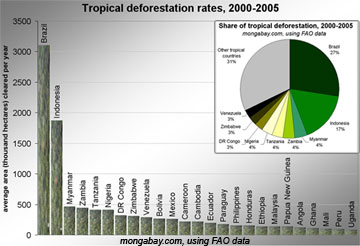Indonesia’s peat swamps worth $39B/year
Indonesia’s peat swamps worth $39B/year
mongabay.com
July 11, 2007
Indonesia’s peat swamps are worth $39 billion in carbon credits per year, according to rough calculations by Bloomberg.
Drainage and destruction of carbon-rich peat swamps releases up to 2 billion tons of carbon per year in Indonesia, according to estimates by Wetlands International, a Dutch NGO. The emissions make Indonesia the third largest producer of greenhouse gases despite having the world’s twenty second largest economy.
Analysts say reducing these emissions could help slow global warming while paying significant dividends for Indonesia. At the going rate of 14.59 euros per ton of carbon offset, eliminating these emissions would be worth 29 billion euros ($39 billion), or more than the $30.1 billion value of the global emissions-credit trade in 2006.
While the tally is significant, there is presently no way for Indonesia to capitalize on this compensation. Environmentalists say that establishing such a mechanism could help reduce deforestation, cut greenhouse gas emissions, and improve rural livelihoods in some of world’s poorest regions.
“This value highlights the potential of this market, however no international incentive system exists to encourage countries to sustain and restore these threatened carbon stocks. Cuts in carbon emissions made by avoiding peat soil degradation are not covered by the UN-controlled Clean Development Mechanism (CDM), for example. In fact, no official carbon trade agreements include the emissions that are avoided when the carbon locked in soils is kept intact,” said Wetlands International in a statement calling for “a global finance mechanism to trigger large-scale restoration and management of wetlands”.
“The benefits would be carbon storage, poverty reduction and biodiversity conservation,” Wetlands continued. “A dedicated wetlands carbon fund could allow investing companies to compensate for their emissions and could result in trade. The funds generated would be used to sustain the carbon stocks in tropical peatswamps and would also help sustain local livelihoods and conserve a massive biodiversity treasure.”
Wetlands estimates that peatlands in Southeast Asia store at least 42 billion metric tons of soil carbon or peat carbon, which if exposed to oxygen in air or burned, would potentially create 155 billion tons of carbon dioxide emissions, according to Bloomberg. Total global carbon dioxide emissions from fuel combustion were 26.6 billion tons in 2004, according to the International Energy Agency. Emissions from deforestation are thought to account for about a fifth of total carbon dioxide emissions.
Related articles
Reducing tropical deforestation will help fight global warming.
(5/10/2007) Scientists have lent support to a plan by developing countries to fight global warming by reducing deforestation rates. Tropical deforestation releases more than 1.5 billion metric tons of carbon into the atmosphere every year, though in some years, like the 1997-1998 el Nino year when fires released some 2 billion tons of carbon from peat swamps alone in Indonesia, emissions are more than twice that. Writing in the journal Science, an international team of scientists argue that the Reducing Emissions from Deforestation (RED) initiative, launched in 2005 by the United Nations Framework Convention on Climate Change, is scientifically and technologically sound, and that political and economic challenges facing the plan can be overcome.
Carbon finance could mean billions for Indonesia.
(11/6/2006) Indonesia could earn billions of dollars for reducing its deforestation rate through a carbon finance mechanism under consideration this week at U.N. climate negotiations in Nairobi, Kenya.
Avoided deforestation could send $38 billion to third world under global warming pact.
(10/31/2006) Avoided deforestation will be a hot point of discussion at next week’s climate meeting in Nairobi, Kenya. Already a coalition of 15 rainforest nations have proposed a plan whereby industrialized nations would pay them to protect their forests to offset greenhouse gas emissions. Meanwhile, last month Brazil — which has the world’s largest extent of tropical rainforests and the world’s highest rate of forest loss — said it promote a similar initiative at the talks. At stake: potentially billions of dollars for developing countries. When trees are cut greenhouse gases are released into the atmosphere — roughly 20 percent of annual emissions of such heat-trapping gases result from deforestation and forest degradation. Avoided deforestation is the concept where countries are paid to prevent deforestation that would otherwise occur. Policymakers and environmentalists alike find the idea attractive because it could help fight climate change at a low cost while improving living standards for some of the world’s poorest people and preserving biodiversity and other ecosystem services. A number of prominent conservation biologists and development agencies including the World Bank and the U.N. have already endorsed the idea.
